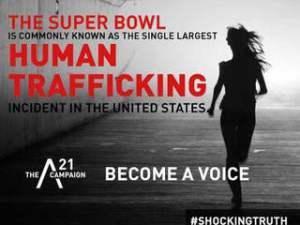While Scripture forbids us from spreading a false report…sometimes, because of lack of information, we unintentionally pass along false reports in the form of myths and urban legends. - Joe Carter of The Gospel Coalition
 Every year since I’ve been writing this blog, the “sex trafficking” fanatics have hyped the Super Bowl as “the biggest human trafficking event of the year”, and every year I and other activists have worked to debunk that ridiculous lie. Though such tall tales had been told about large international events like the Olympics and World Cup since the advent of “trafficking” hysteria in 2004, they first became attached to the Super Bowl in 2008 and didn’t blossom into a full-fledged media circus until 2010, when were told that “‘tens of thousands of people‘—most of them young girls—[were] sold into the sex trade during Miami’s Super Bowl” (presumably while the halftime show was going on). Later that year, Texas attorney general Greg Abbot got the propaganda machine running in full force by November, and virtually the only dissenting voice outside the sex worker rights movement was a Village Voice reporter who interviewed me a few weeks before the Dallas game. In October 2011, however, the venerable Global Alliance Against Traffic in Women released a thorough debunking entitled “What’s the Cost of a Rumour?”, and a few “trafficking” opportunists began to see the writing on the wall. While the hysteria spun on for the 2012 Indianapolis Super Bowl (the first one which saw the bizarre spectacle of nuns and “trafficking” fetishists harassing hoteliers into accepting creepy bars of “sex trafficking” soap), a few of the wiser rescue industry groups began to distance themselves from it and Snopes officially labeled it an urban legend.
Every year since I’ve been writing this blog, the “sex trafficking” fanatics have hyped the Super Bowl as “the biggest human trafficking event of the year”, and every year I and other activists have worked to debunk that ridiculous lie. Though such tall tales had been told about large international events like the Olympics and World Cup since the advent of “trafficking” hysteria in 2004, they first became attached to the Super Bowl in 2008 and didn’t blossom into a full-fledged media circus until 2010, when were told that “‘tens of thousands of people‘—most of them young girls—[were] sold into the sex trade during Miami’s Super Bowl” (presumably while the halftime show was going on). Later that year, Texas attorney general Greg Abbot got the propaganda machine running in full force by November, and virtually the only dissenting voice outside the sex worker rights movement was a Village Voice reporter who interviewed me a few weeks before the Dallas game. In October 2011, however, the venerable Global Alliance Against Traffic in Women released a thorough debunking entitled “What’s the Cost of a Rumour?”, and a few “trafficking” opportunists began to see the writing on the wall. While the hysteria spun on for the 2012 Indianapolis Super Bowl (the first one which saw the bizarre spectacle of nuns and “trafficking” fetishists harassing hoteliers into accepting creepy bars of “sex trafficking” soap), a few of the wiser rescue industry groups began to distance themselves from it and Snopes officially labeled it an urban legend.
Since then, we’ve begun to see a split in both political and journalistic treatment of the myth. While New Orleans’ response was even less extreme than Tampa’s in 2009, New Jersey has gone completely off the deep end, New York has horned in on New Jersey’s glory by performing mass arrests of sex workers in the name of “fighting trafficking”, and Cindy McCain, angry that the hysteria had not started in earnest the last time the game was in Phoenix (2008), has already started trying to hog the spotlight for next year. While some media outlets published the usual outlandish poppycock, others are trying to hedge their bets: Jezebel was as credulous as one would expect, but its readers were not (see comment thread), and NBC News took the precaution of inserting a couple of disclaimers in an otherwise-typical “Trafficking Bowl” feature starring SOAP’s Theresa Flores (who was magically “trafficked” out of her suburban home every night for two years without anyone ever noticing). And like rats deserting a sinking ship, Rachel Lloyd and Polaris are now denying the myth in hopes of keeping the broader “sex trafficking” mythology (and their profits) afloat just a little longer.
Nor is it just a few lonely voices doing the debunking any more, as it was for the past three years. My article in Reason was quoted and linked in articles on Hot Air, Cracked and The Federalist, and Lenore Skenazy interviewed me for her syndicated newspaper column and Huffington Post. Susan Shepard of Tits and Sass exploded the myth in Sports on Earth, Tracy Clark-Flory did in Salon, Dr. Marty Klein did on his own blog, and Kate Mogulescu of the Legal Aid Society did in the New York Times; other writers attacked it in The Wire and the National Post. But the most pleasant surprises for me were two refutations in The Gospel Coalition and Religious Herald; the latter one even quoted Laura Agustín! Given all this support to what once felt like tilting at windmills, I think it’s safe to say that the next iteration of the myth (which as mentioned above, Cuckoo Clock McCain has already launched) will be its swan song. And that will only be one of a series of implosions which will rock the “sex trafficking” cult over the next three years, resulting in the eventual collapse of the whole moral panic.
Given all this support to what once felt like tilting at windmills, I think it’s safe to say that the next iteration of the myth (which as mentioned above, Cuckoo Clock McCain has already launched) will be its swan song. And that will only be one of a series of implosions which will rock the “sex trafficking” cult over the next three years, resulting in the eventual collapse of the whole moral panic.
